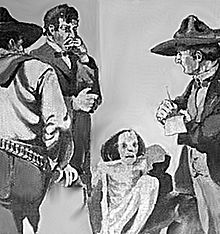
Aztec mummy refers to an intentionally prepared or naturally desiccated human body of Aztec origin.

Aztec mummy refers to an intentionally prepared or naturally desiccated human body of Aztec origin.
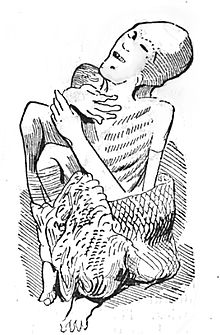
Distinctions must be made between intentionally prepared Aztec mummies and mummies resulting from natural desiccation. Prepared Aztec mummy “bundles” consist of the remains of the deceased placed in a woven bag or wrap which was often adorned with a ceremonial mask. [1] Most of the more widely known examples of Aztec mummies, which formed the basis of popular traveling exhibitions [2] and museum exhibits [3] in the 19th century, were likely the product of natural desiccation rather than an intentional mummification process.
Unlike Egyptian mummies, which were typically placed in an extended supine position within a sarcophagus, Aztec mummies were typically placed in seated positions. To maintain the pose of the body, the remains were often secured within a cloth wrapping, sometimes with rope.

A mummy is the Aztec hieroglyph for death. [4] In Aztec written documentation of historical events, such as the death of a ruler or warrior, a mummy glyph will be connected to a glyph denoting the person's name and another glyph denoting the year of the event.
The pictured example of Aztec hieroglyphs shows the mummy of a human figure bound with ropes, with a crown on its head, indicating the death of a ruler. The small water-animal attached to the crown by a cord shows that the dead ruler's name was Ahuitzotl, that being the Aztec word for "water-animal". The right half of the glyph shows a man seated upon a dais, with a crown on his head and a speech-scroll issuing from his mouth. The Aztec word for ruler was "tlahtouani", "he who speaks", shown graphically by the speech-scroll. Finally both figures are attached by cords to the circle above, which represents the year "10-Rabbit" (1502 A.D.), indicating the date of this event. [4]
In the late 19th century, resurrected Aztec mummies replaced their Egyptian counterparts in popular American stories such as The Squaw Hollow Sensation, which appeared in 1879 and told the story of "the discovery and revival of a 1000-year-old Aztec mummy". [5] [6] Aztec mummy-themed stories continued in American novels, films, comic books, and television throughout the 20th century and into the 21st century. Notable examples include fictional confrontations between Aztec mummies and the Lone Ranger (comic book), Kolchak: The Night Stalker (television), and Mil Mascaras vs. the Aztec Mummy (film).
Aztec mummy-themed horror films produced in Mexico include La Momia Azteca , which was the first of a trilogy of films produced in 1957 featuring a resurrected Aztec warrior named Popoca, followed by The Curse of the Aztec Mummy and The Robot vs. The Aztec Mummy . The later film Wrestling Women vs. the Aztec Mummy (1964) featured a resurrected Aztec warrior named Tezomoc, [7] and Mexican mummies were again featured in The Mummies of Guanajuato. [8] Unlike the Aztec mummies appearing in most American film and television productions, which are typically mummified as part of a ceremonial process similar to Egyptian mummies, Mexican horror films typically involve the resurrection of naturally desiccated Aztec warriors. The 2007 American film Mil Mascaras vs. the Aztec Mummy , starring the aforementioned Mexican superstar wrestler Mil Máscaras, features the ceremonial resurrection of a mummy in a sarcophagus that is more reminiscent of Egyptian mummies than Aztec ones.

A mummy is a dead human or an animal whose soft tissues and organs have been preserved by either intentional or accidental exposure to chemicals, extreme cold, very low humidity, or lack of air, so that the recovered body does not decay further if kept in cool and dry conditions. Some authorities restrict the use of the term to bodies deliberately embalmed with chemicals, but the use of the word to cover accidentally desiccated bodies goes back to at least the early 17th century.
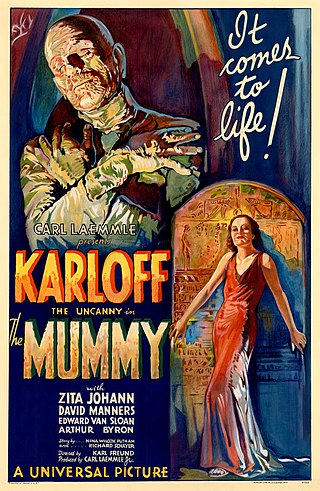
The Mummy is a 1932 American pre-Code supernatural horror film directed by Karl Freund. The screenplay by John L. Balderston was adapted from a treatment written by Nina Wilcox Putnam and Richard Schayer. Released by Universal Studios as a part of the Universal Monsters franchise, the film stars Boris Karloff, Zita Johann, David Manners, Edward Van Sloan and Arthur Byron.

Mil Máscaras is a Mexican luchador and actor. He is regarded as one of the greatest wrestlers of the lucha libre tradition in Mexico – along with El Santo and Blue Demon – and has been described as the first international superstar of lucha libre. Mil Máscaras is considered one of the most influential wrestlers of all time for enhancing and popularizing the lucha libre style around the world, both in the ring and as the star of 20 films. He is also an accomplished artist and cultural ambassador for his native country and has appeared on three of its postage stamps. Although he has never been unmasked and his true identity is generally kept a secret out of respect for lucha libre traditions, his real name is known due to appearing in the credits of the films he has starred in. His ring name is Spanish for "Thousand Masks".

José Luis Rodríguez Arellano is a Mexican Luchador Enmascarado who wrestles under the ring name Dos Caras. His most active years were in the 1970s and 1980s, and he achieved his greatest success in Mexico's Universal Wrestling Alliance (UWA), where he won the UWA World Heavyweight Championship three times. He has been called "the greatest heavyweight ever to come out of Mexico". He is the creator of the Dos Caras Clutch, a hammerlock head scissors pinning combination.

La Casa del Terror is a Mexican Monster movie starring Lon Chaney Jr. and Mexican comedian Tin Tan. The film involves Casimiro (Tin-Tan), a night watchman in a Wax Museum, whose boss, Professor Sebastian, has been secretly draining his blood to use in his experiments in resurrection. A mummy who is stolen from an Egyptian sarcophagus is revived to life, and becomes a werewolf when moonlight hits him.

The Robot vs. the Aztec Mummy is a 1958 Mexican science fiction horror film directed by Rafael Portillo, and starring Ramón Gay and Rosa Arenas. It is the third installment in a trilogy preceded by The Aztec Mummy and The Curse of the Aztec Mummy, and a large portion of the film is an extended recap of the events from the first two entries. The three films were all shot consecutively.

Luchador films are Mexican professional wrestling/action/science-fiction/horror films starring some of the most popular masked luchadores in Lucha Libre. The luchadores are portrayed as superheroes engaging in battles against a range of characters from spies, to vampires and Martians. These films were low-budget and produced quickly. Nearly all lucha films included fist-fighting and wrestling action sequences in and out of the ring which were choreographed and performed by the stars themselves without the aid of stunt doubles. The genre's popularity peaked during the mid-1960s to early-1970s. At least 150 luchador films were produced starting with the 1952 film Huracán Ramírez.
Máximino Linares Moreno was a Mexican luchador and lucha film star, better known under the ring name Rayo de Jalisco. He is considered to be one of the best wrestlers of his generation. Linares' son followed in his footsteps and is working under the name Rayo de Jalisco Jr., wearing the same distinctive black mask with silver lightning bolt on it when wrestling. One of Linares' grandsons is also a wrestler, known as "Rayman".
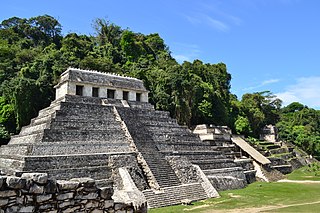
The Temple of the Inscriptions is the largest Mesoamerican stepped pyramid structure at the pre-Columbian Maya civilization site of Palenque, located in the modern-day state of Chiapas, Mexico. The structure was specifically built as the funerary monument for K'inich Janaab' Pakal, ajaw or ruler of Palenque in the 7th century, whose reign over the polity lasted almost 70 years. Construction of this monument commenced in the last decade of his life, and was completed by his son and successor K'inich Kan B'alam II. Within Palenque, the Temple of the Inscriptions is located in an area known as the Temple of the Inscriptions’ Court and stands at a right angle to the Southeast of the Palace. The Temple of the Inscriptions has been significant in the study of the ancient Maya, owing to the extraordinary sample of hieroglyphic text found on the Inscription Tablets, the impressive sculptural panels on the piers of the building, and the finds inside the tomb of Pakal.

Blue Demon Jr. is a Mexican professional wrestler. He is the adopted son of the original Blue Demon and is the first Mexican and second masked wrestler to win the NWA World Heavyweight Championship thus making him a one-time world champion. His government name has never been officially disclosed to the public, as is often the case with masked wrestlers in Mexico where their on-stage personas are kept separate from their personal lives.

Mil Mascaras vs. the Aztec Mummy is a 2007 Mexican-American lucha libre film starring the legendary Mexican wrestler and cult film star Mil Máscaras. It has the distinction of being the first lucha film starring any of the "Big 3" to be produced in English. It was a tribute to the 1960s Mexican horror and lucha libre films and was the first of a trilogy of Mil Mascaras films that includes Academy of Doom (2008) and Aztec Revenge (2015).

Chip Gubera is an American film director and producer. He also teaches digital media technology at the University of Missouri in the IT Program.

The Curse of the Aztec Mummy is a 1957 Mexican horror film directed by Rafael Portillo. It is the second film in the Aztec Mummy series which began with The Aztec Mummy which was released earlier that year.

Revenge of the Mummy, officially named Revenge of the Mummy: The Ride, is an enclosed roller coaster located at Universal Studios Florida, Universal Studios Hollywood, and Universal Studios Singapore. It is themed to The Mummy film franchise, and the ride features linear induction motors (LIMs) that launch riders to a maximum speed of 40 mph (64 km/h) in a matter of seconds. The Florida and Singapore locations have the same track layout, although each location offers a slightly different virtual experience. Manufactured by Premier Rides, the attractions feature track switches installed by Dynamic Structures. Universal Creative and ITEC Entertainment Corporation created the theme at each location, with Adirondack Studios responsible for several of the unique elements implemented at the Singapore location.

Tula is a Mesoamerican archeological site, which was an important regional center which reached its height as the capital of the Toltec Empire between the fall of Teotihuacan and the rise of Tenochtitlan. It has not been well studied in comparison to these other two sites, and disputes remain as to its political system, area of influence and its relations with contemporary Mesoamerican cities, especially with Chichen Itza. The site is located in the city of Tula de Allende in the Tula Valley, in what is now the southwest of the Mexican state of Hidalgo, northwest of Mexico City. The archeological site consists of a museum, remains of an earlier settlement called Tula Chico as well as the main ceremonial site called Tula Grande. The main attraction is the Pyramid of Quetzalcoatl, which is topped by four 4-metre-high (13 ft) basalt columns carved in the shape of Toltec warriors. Tula fell around 1150, but it had significant influence in the following Aztec Empire, with its history written about heavily in myth. The feathered serpent god Quetzalcoatl is linked to this city, whose worship was widespread from central Mexico to Central America at the time the Spanish arrived.
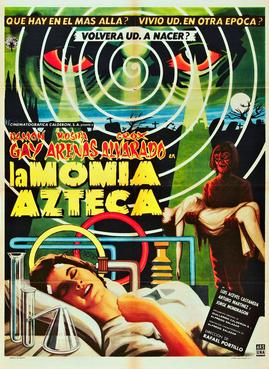
The Aztec Mummy is a 1957 Mexican adventure horror film produced by Guillermo Calderon from his own story idea, scripted by Alfredo Salazar, and directed by Rafael Portillo. The plot centers on a group of scientists who uncover a secret Aztec tomb through past-life regression, only to awaken an ancient warrior who has been cursed to guard the tomb and its hidden treasures. It is the first of a trilogy featuring the titular character, all filmed back-to-back in order to increase potential profit.

Mummies are commonly featured in horror genres as undead creatures wrapped in bandages. Similar undead include skeletons and zombies.

Academy of Doom is a 2008 Mexican-American lucha libre film directed by Chip Gubera and starring the legendary Mexican masked wrestler and film star Mil Máscaras. It shared production personnel with Mil Mascaras vs. the Aztec Mummy (MMvsAM) and was completed at the same time as that film and screened with it at several film festivals.

Aztec Revenge is a 2015 American lucha libre film starring the legendary Mexican masked wrestler and film star Mil Máscaras. It continues a storyline from the popular 2008 film, Mil Mascaras vs. the Aztec Mummy, and is the third of a trilogy of films that also includes Academy of Doom.
{{cite journal}}: Missing or empty |title= (help)